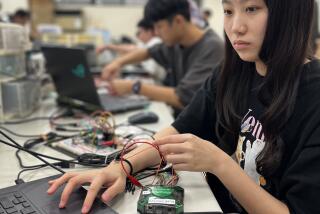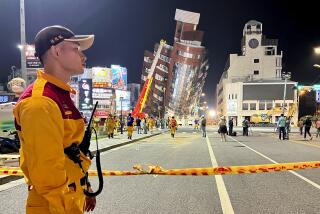Taiwan Breaks Out as a Global Investor : Capital: High labor costs and appreciating currency have pushed Taiwanese companies to invest billions overseas.
TAIPEI, Taiwan — After years of tending their own garden, Taiwan business executives have entered the world’s financial markets loaded with cash.
Faced with higher labor costs and a rapidly appreciating Taiwanese dollar, hundreds of Taiwanese companies are investing billions overseas--from sweatshop textile firms in China’s Fujian province to high-tech computer operations in Palo Alto, Calif.
A government-backed consortium in November announced a plan to buy a $2-billion chunk of McDonnell Douglas Corp., America’s second-biggest aerospace manufacturer. Since 1990, Taiwanese high-tech firms have plunked down $400 million in Silicon Valley. Billions more have been invested in Southeast Asia. In 1990, for the first time Taiwan topped Japan as Malaysia’s No. 1 investor with an estimated $2.3 billion.
Taiwan also leads the race in Indochina, investing more than $530 million in Vietnam since the communist nation opened to foreign investors several years ago.
Taiwanese companies are targeting the belt along the Rio Grande to exploit a planned free-trade agreement between the United States, Mexico and Canada. For example, Formosa Plastics has built a $1.3-billion naptha distillation plant in Port Lavaca, Tex.
Taiwanese business now invests in its longtime enemy, communist China, at a faster rate than any country. Although the Nationalist government bans direct investment in the Mainland, it allows indirect trade. So far, an estimated $3 billion has rolled into China from across the Taiwan Straits.
“Taiwan is now a major player in Asian investment. It also has its sights on Europe and the United States,” said Jeff Toder, an American economist at the brokerage house Jardine Flemings Securities in Taipei. “We expect them to expand, expand, expand.”
Economic Ministry figures show how dramatically Taiwan’s foreign investment has multiplied. The value of government-approved deals abroad totaled less than $60 million from 1959-79. In 1987, foreign investment contracts totaled $103 million. They more than doubled to $219 million in 1988, totaled $931 million in 1989 and have exceeded $1 billion in each of the past two years.
Ricky Gao, acting director general of the Industrial Development and Investment Center of the Ministry of Economic Affairs, says those figures vastly understate the true level of foreign investment by Taiwanese businesses, since much of it goes unreported.
By some estimates, Taiwan is now directly and indirectly investing more than $6 billion a year overseas. Taiwan’s push abroad reads like a case study of what a developing nation must do to continue breakneck growth first fueled by exports. For decades, Asia’s four Little Dragons--Hong Kong, Taiwan, South Korea and Singapore--followed the Japanese model of the 1950s and built their economies by pumping out a succession of cheap consumer products.
This export-led growth has fueled miraculous expansion. Between 1971 and 1991, gross national product jumped from $6.6 billion to $180 billion, transforming Taiwan, an island the size of West Virginia, into the world’s 15th-biggest economy. Foreign currency reserves, fattened by trade surpluses with the United States, also increased to about $80 billion, a world high.
But with growth, wages skyrocketed. Per capita income shot up from $443 in 1971 to $8,800 in 1991, third-highest in Asia behind Japan and Hong Kong.
Under pressure from Washington to cut its trade surplus, the government also allowed the Taiwanese dollar to appreciate--nearly 40% against the U.S. dollar in five years. Now many Taiwanese companies face a choice--either move to cheaper markets and cut labor costs or upgrade their technology. Industries also have to persuade picky shoppers around the world that “made in Taiwan” means quality.
Taiwan’s government has supported the push abroad. In 1987, it relaxed tight restrictions on moving foreign currency out of Taiwan, allowing each adult a limit of $3 million a year. Companies controlled by Taiwan’s ruling Nationalist Party, considered the richest political party in the world, also backed many of the projects. Gao said the government viewed foreign investment as a chance to increase Taiwan’s international stature, crippled in 1979 when the United States dropped recognition of Taiwan in favor of communist China.
To encourage high-tech firms, the government established Science Park, a manufacturing zone outside Taipei. It also granted tax holidays and low interest loans. Now 22,000 people work there and exports totaled $3.5 billion in 1991.
Strings of factories that churned out sweaters, telephones and toaster ovens were the first to leave Taiwan, migrating through Hong Kong to Mainland China. David Wei heads one traditional Taiwanese family-owned firm, Solemn International. Factories controlled by Solemn make underwear in Fujian, car stereos in Malaysia and trinkets in Thailand.
“The reason we’re still in business is that we’re flexible,” he said. “Flexible and very fast.” The 1980s also saw the development of new companies structured not on the traditional Chinese clan but more like an American business.
Stan Shih got together with friends in 1976 and used start-up capital of $25,000 to found Acer Computer. In 1986, the firm launched the world’s second 32-bit personal computer, ahead of IBM but behind Compaq. In 1991, Acer’s combined sales totaled $ 1 billion.
In 1990, Acer paid $94 million for Altos, a Silicon valley firm, to improve its marketing network. Shih said he hopes firms such as Altos can help Taiwanese companies break into the international market with their own brands.
More to Read
Inside the business of entertainment
The Wide Shot brings you news, analysis and insights on everything from streaming wars to production — and what it all means for the future.
You may occasionally receive promotional content from the Los Angeles Times.










